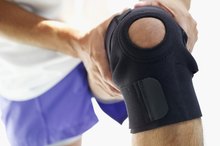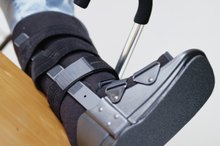Exercising with a Tibia Fracture
Exercises for a fractured tibia aim to expedite the healing process as well as improve the range of motion in your ankle and surrounding joints. Depending on the severity of the fracture, you will begin exercise and rehabilitation stretches anywhere from two weeks to two months after diagnosis. Check with your physician before beginning any exercise routine.
Tibia Fractures
The tibia is the largest of your two shinbones. Tibia injuries range in severity from stress fractures -- cracks in the bone due to overuse -- to traumatic compound fractures, in which the bone shatters and pierces the skin. A common type of tibia fracture, the tibial shaft fracture, occurs below the knee joint. While some tibia fractures require an above-knee cast, others need only splints or leg braces. If the fracture is severe enough, you may require surgery to help repair and stabilize the bone, which often involves the insertion of rods and screws in your leg.
- The tibia is the largest of your two shinbones.
- If the fracture is severe enough, you may require surgery to help repair and stabilize the bone, which often involves the insertion of rods and screws in your leg.
Stretching Exercises
Rehab Exercises After MCL Injury
Learn More
Stretching exercises for a tibial fracture help improve the range of motion in your leg before you start putting weight on it again. You can do these exercises soon after the doctor removes your cast or brace. The gastrocnemius stretch requires you to stand facing a wall with both hands held out in front of you at shoulder level. Lean forward against the wall, keeping your feet flat on the floor. Bend your uninjured leg at the knee while keeping your injured leg straight. Hold for 10 seconds before relaxing. Repeat three times. A similar exercise is the soleus stretch, in which you bend both legs while leaning forward against the wall. Hold for 10 seconds, then straighten the injured leg. Repeat three times. Do not perform either exercise if they cause pain in your injured leg.
- Stretching exercises for a tibial fracture help improve the range of motion in your leg before you start putting weight on it again.
Weight-bearing Exercises
Weight-bearing exercises can be performed nine to 10 weeks after initial diagnosis and help to restore your ankle and leg to its original strength. Weight-bearing exercises range from static inversions to proprioception exercises that help strengthen the muscles in your calf. Using either a foam pad or balance pad, these balancing exercises strengthen your legs while improving your balance. They also help restore your coordination, which may be lacking due to weeks of rest and inactivity. Performing weight-bearing exercises in conjunction with regular stretching helps expedite your recovery.
- Weight-bearing exercises can be performed nine to 10 weeks after initial diagnosis and help to restore your ankle and leg to its original strength.
Conditioning Exercises
What Are the Treatments for Thigh Splints?
Learn More
Perform conditioning exercises only after your tibia fracture is completely healed. Conditioning exercises help prevent future fractures and ligament damage by keeping your ankle and body in good physical shape. To start, swim laps in a pool to improve your endurance, stamina and balance without putting extensive weight or pressure on your leg. After swimming, you can transition to biking as a way to condition while keeping your full body weight off your injured leg or ankle. Running and jogging are other good conditioning exercises, although they put extensive pressure on your ankles. Be sure your broken bone is fully mended before taking up running or jogging.
- Perform conditioning exercises only after your tibia fracture is completely healed.
- To start, swim laps in a pool to improve your endurance, stamina and balance without putting extensive weight or pressure on your leg.
Related Articles
References
- Sports Injury Clinic: Stretching (Stress Fracture of the Lower Leg)
- PhysioRoom.com; Strengthening Exercises for a Broken Leg; Marc Bernier; Jan. 6, 2005
- "Annals of Nuclear Medicine"; Exercise-related Longitudinal Tibial Stress Fracture in a Young Person; Frank V. Schraml, et al.; 2006
- Dunbar RP, Cannada LK. Open fractures. American Academy of Orthopaedic Surgeons. Published March 2017.
- Lowe JA. Tibia (shinbone) shaft fractures. American Academy of Orthopaedic Surgeons. Published May 2018.
- Aurich M, Koenig V, Hofmann G. Comminuted intraarticular fractures of the tibial plateau lead to posttraumatic osteoarthritis of the knee: current treatment review. Asian J Surg. 2018;41(2):99-105. doi:10.1016/j.asjsur.2016.11.011
- Crist BD. Pilon fractures of the ankle. American Academy of Orthopaedic Surgeons. Published November 2015.
- Cho JH, Lee IJ, Bang JY, Song HK. Factors affecting clinical outcomes after treatment of extra-articular open tibial fractures. J Orthop Sci. 2016;21(1):63-7. doi:10.1016/j.jos.2015.10.022
- Lowe J, Kottmeier S. Fractures of the proximal tibia (shinbone). American Academy of Orthopaedic Surgeons. Published May 2019.
- Mthethwa J, Chikate A. A review of the management of tibial plateau fractures. Musculoskelet Surg. 2018;102(2):119-127. doi:10.1007/s12306-017-0514-8
Writer Bio
Jason Aberdeene has been a freelance writer since 2008. His articles have appeared in the "UCSD Guardian" and on various websites, specializing in teen health. An assistant at Kagan Physical Therapy since 2009, Aberdeene has a Bachelor of Arts in philosophy from the University of California, San Diego.









